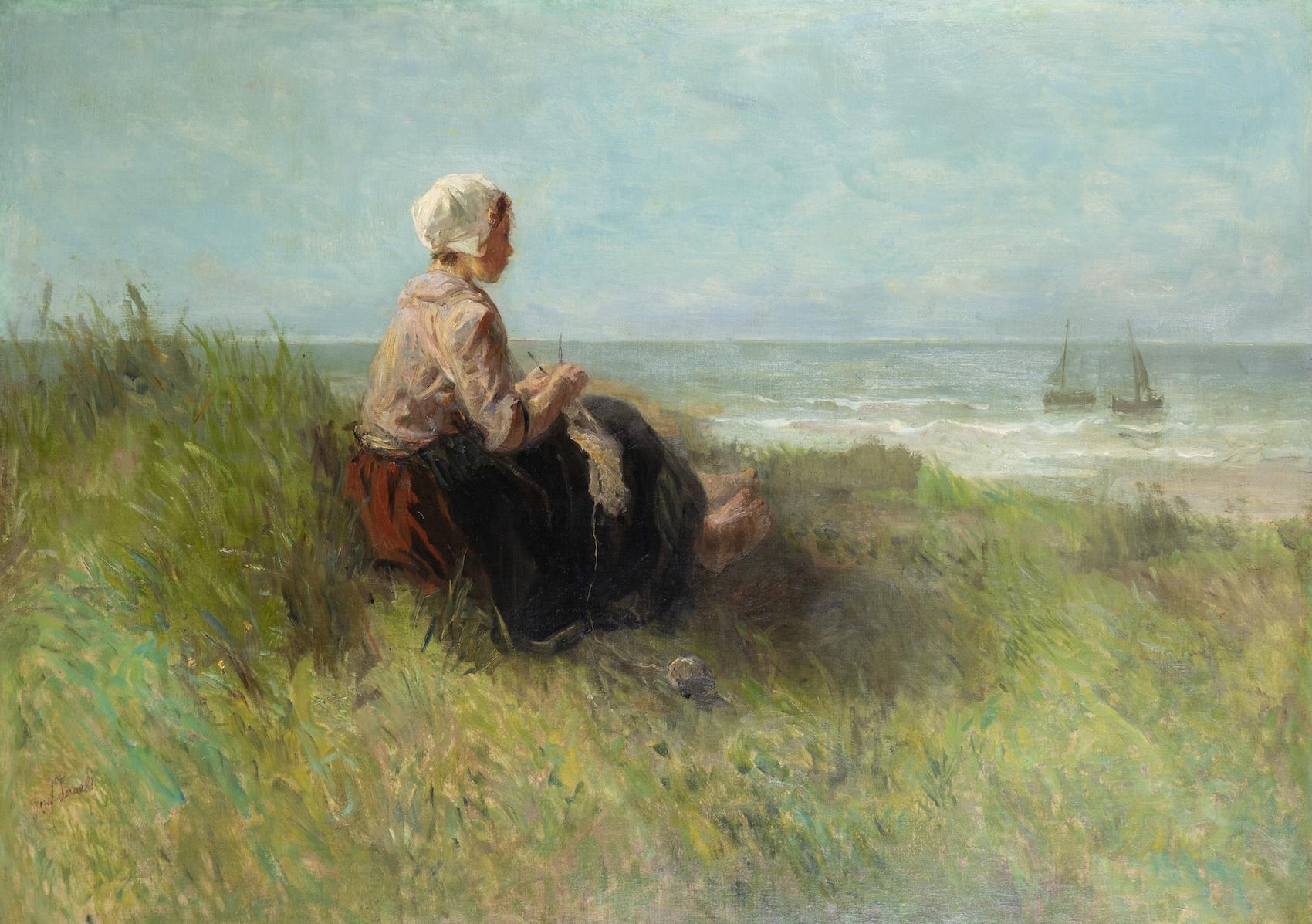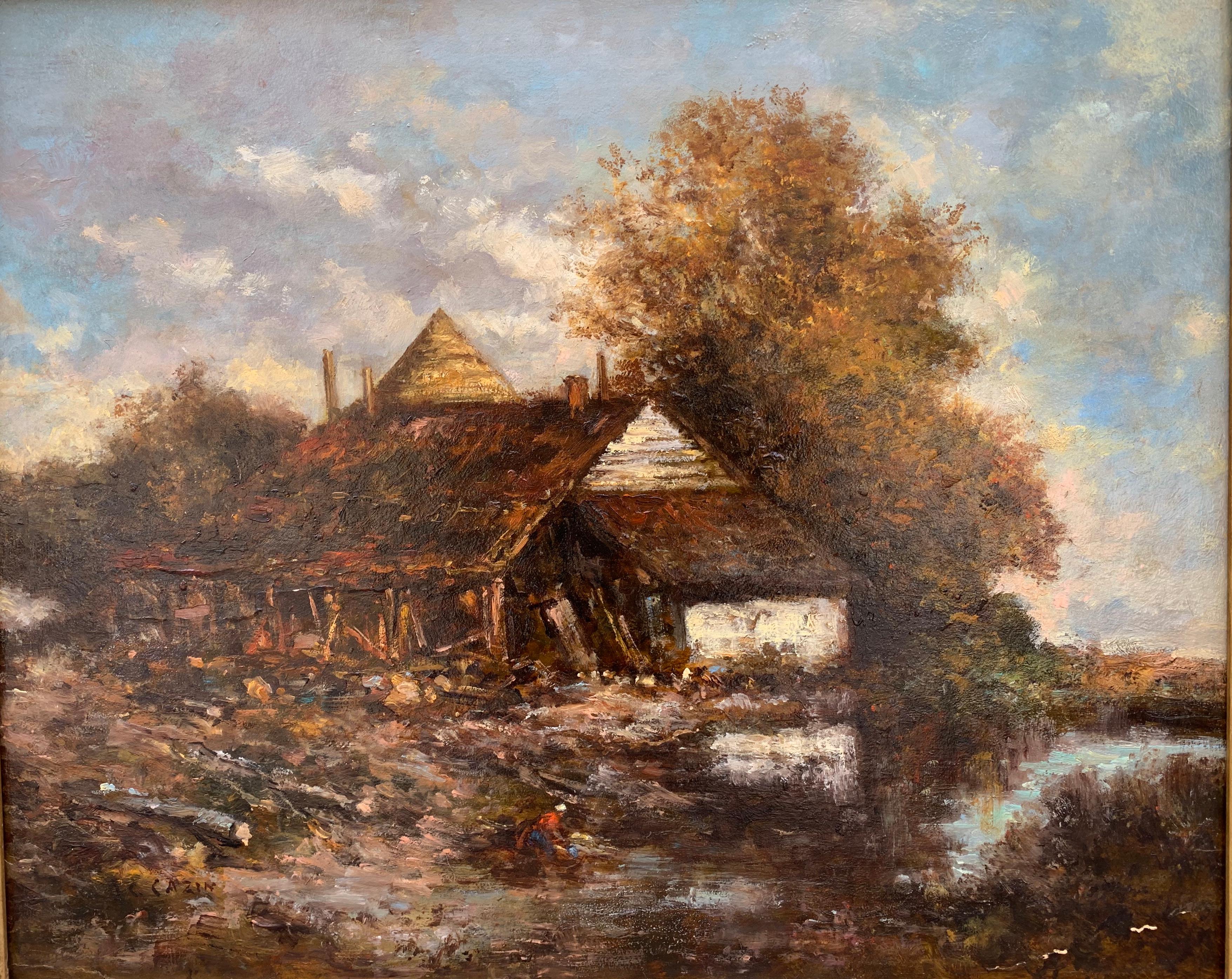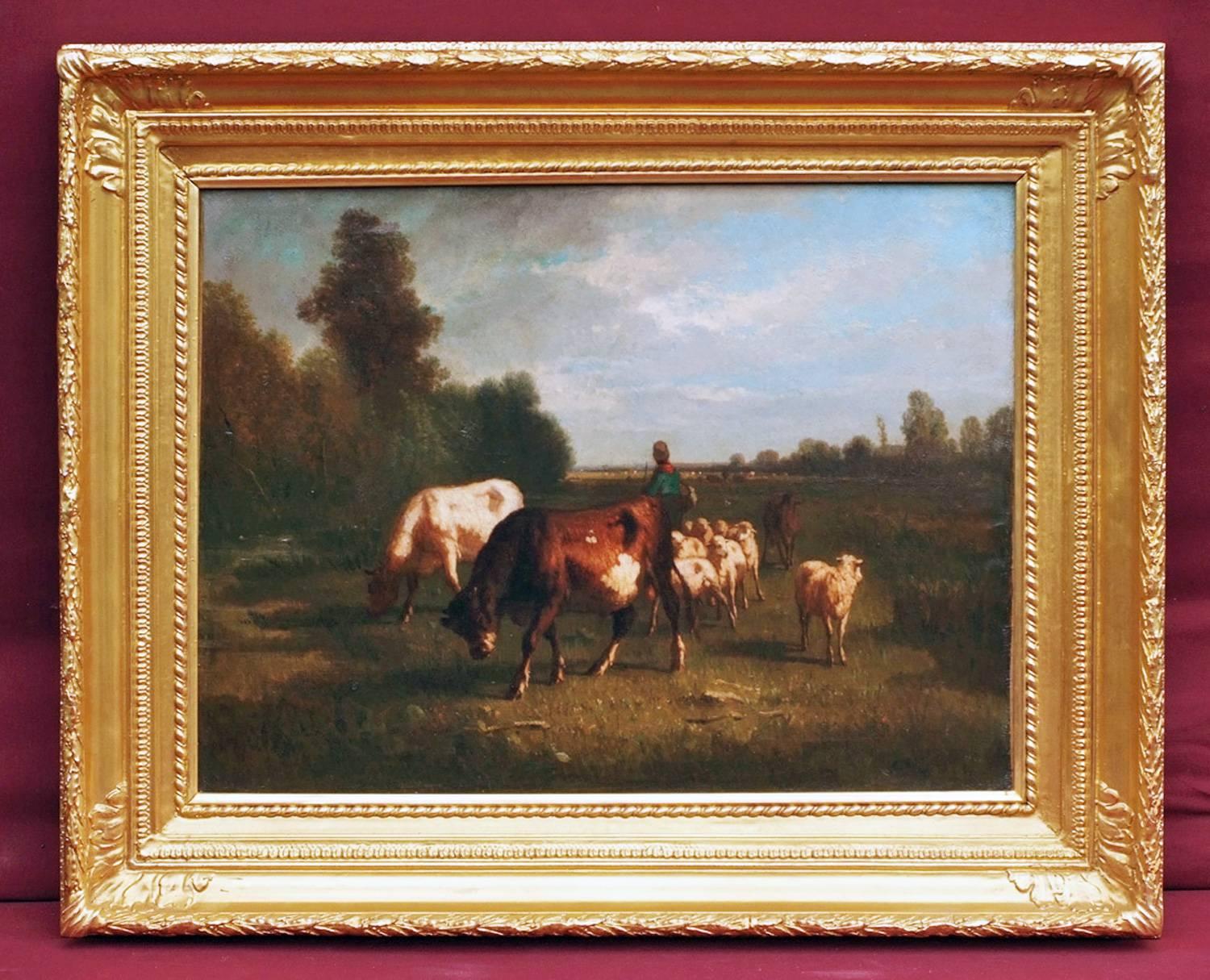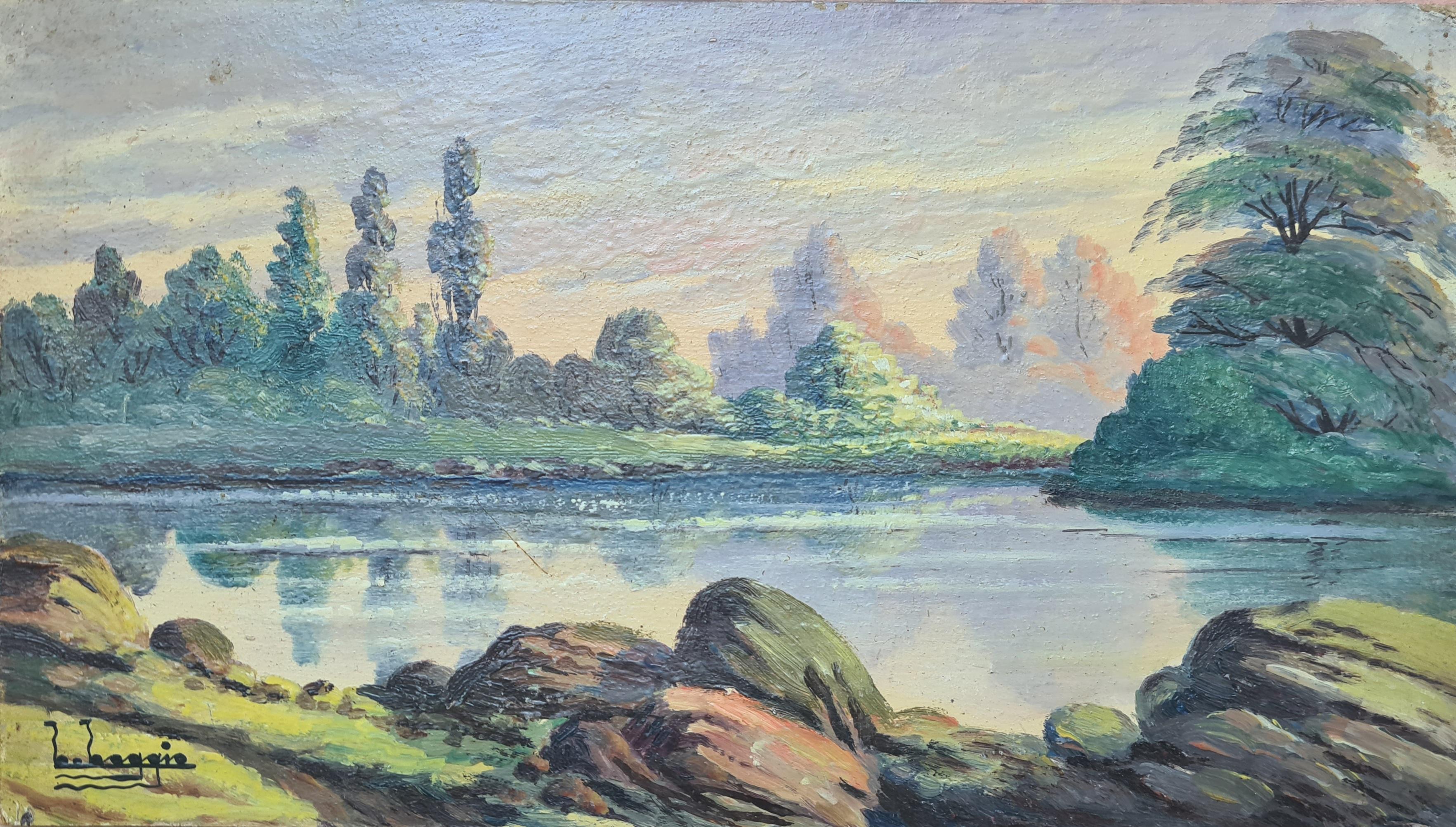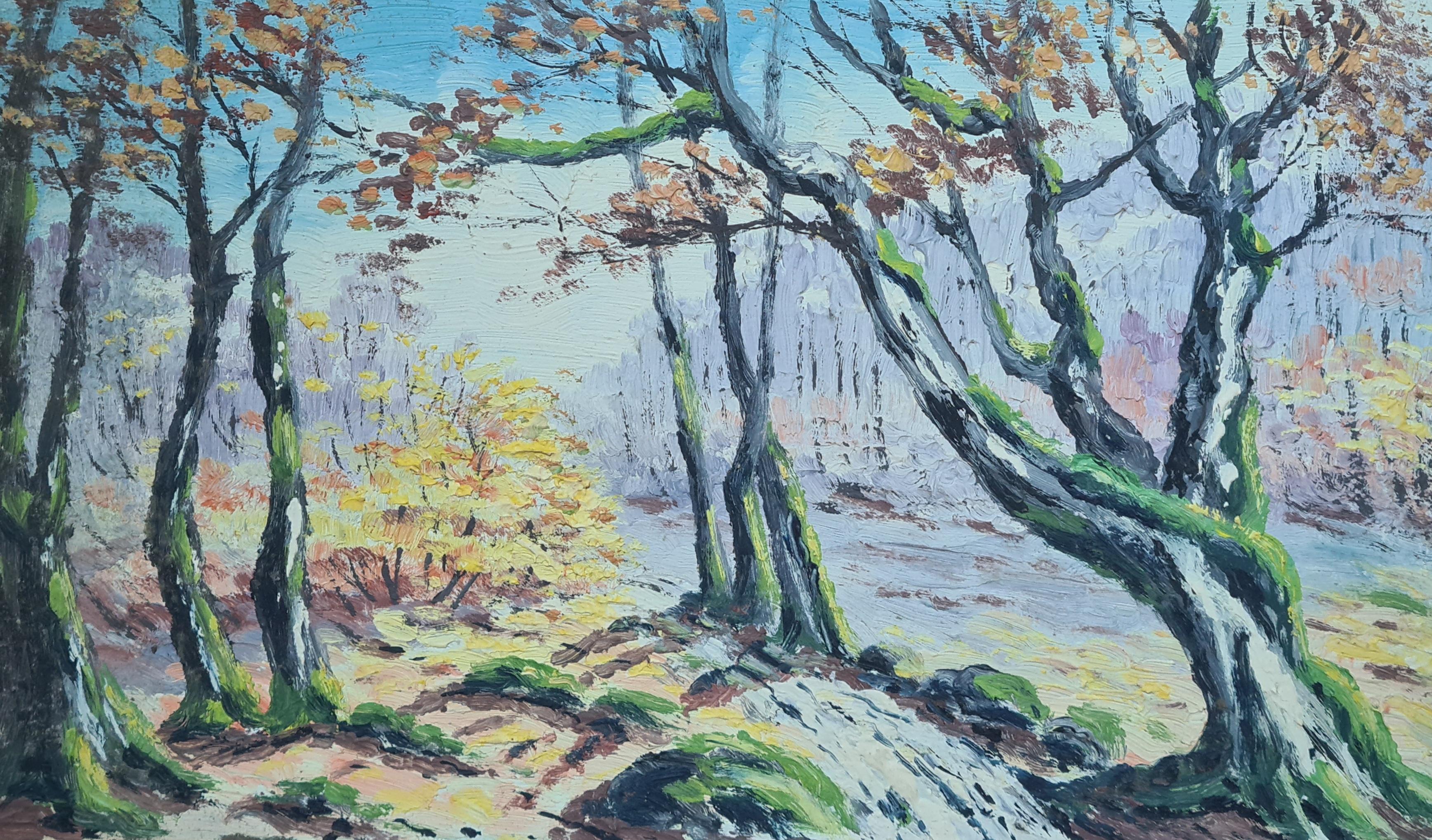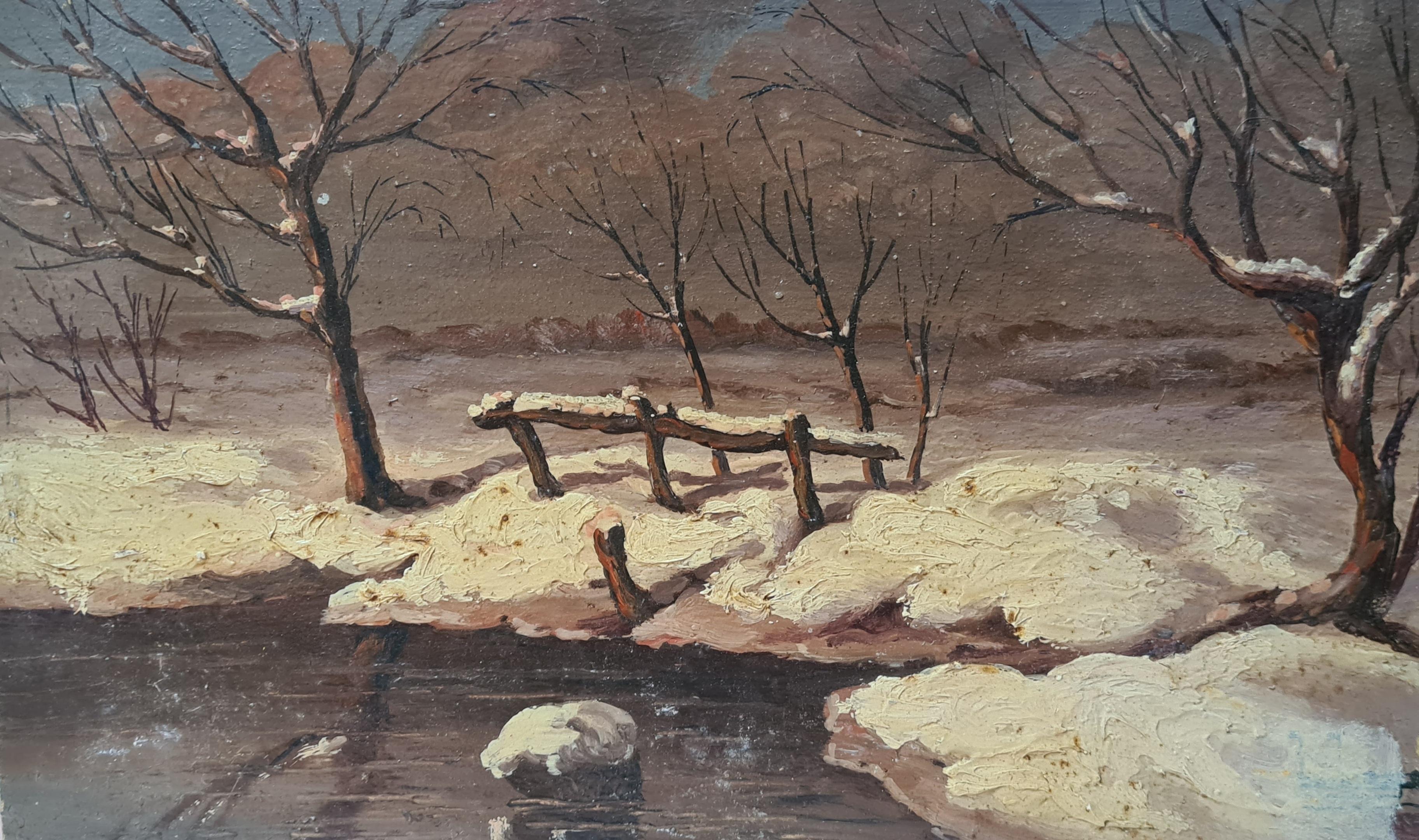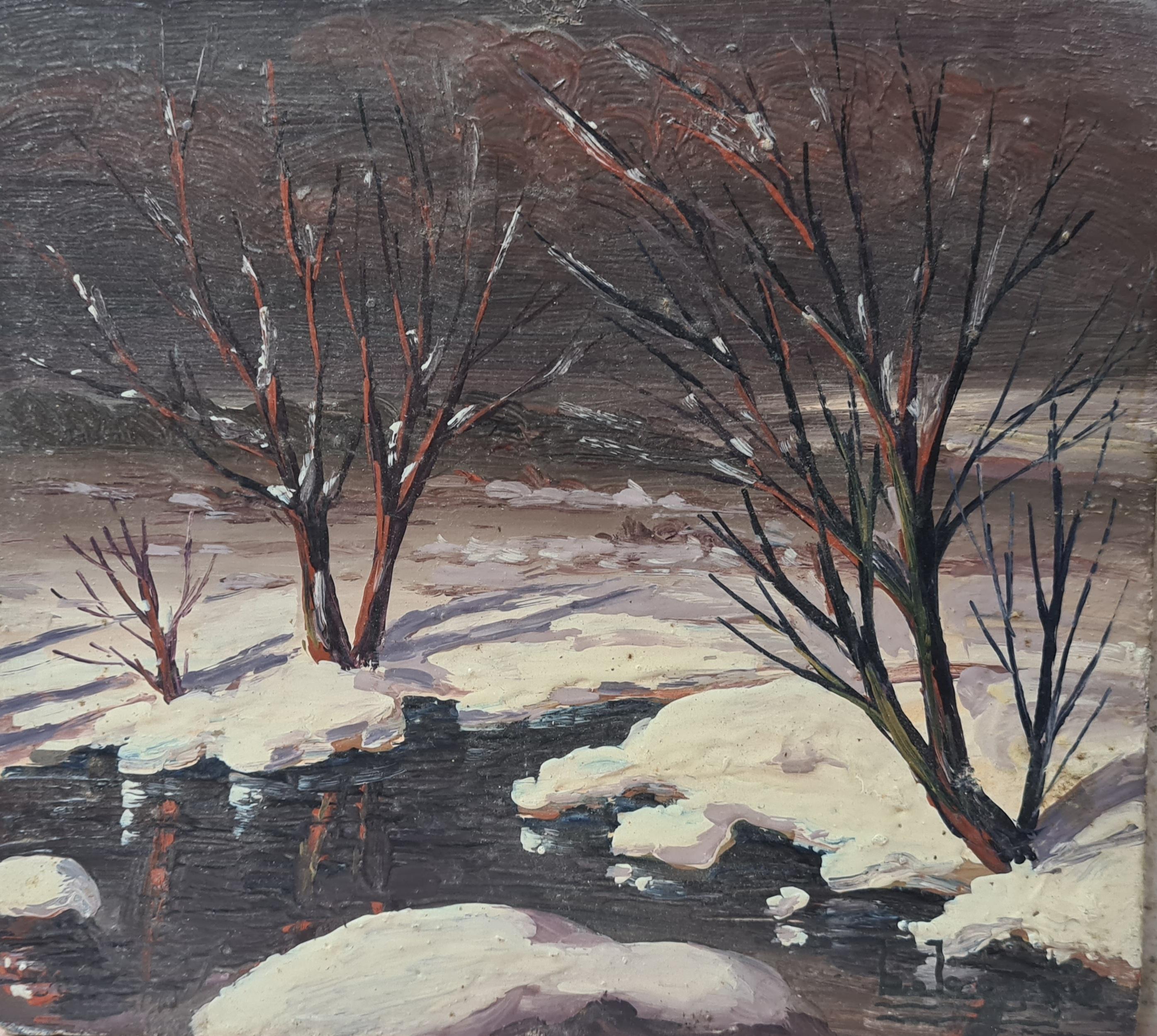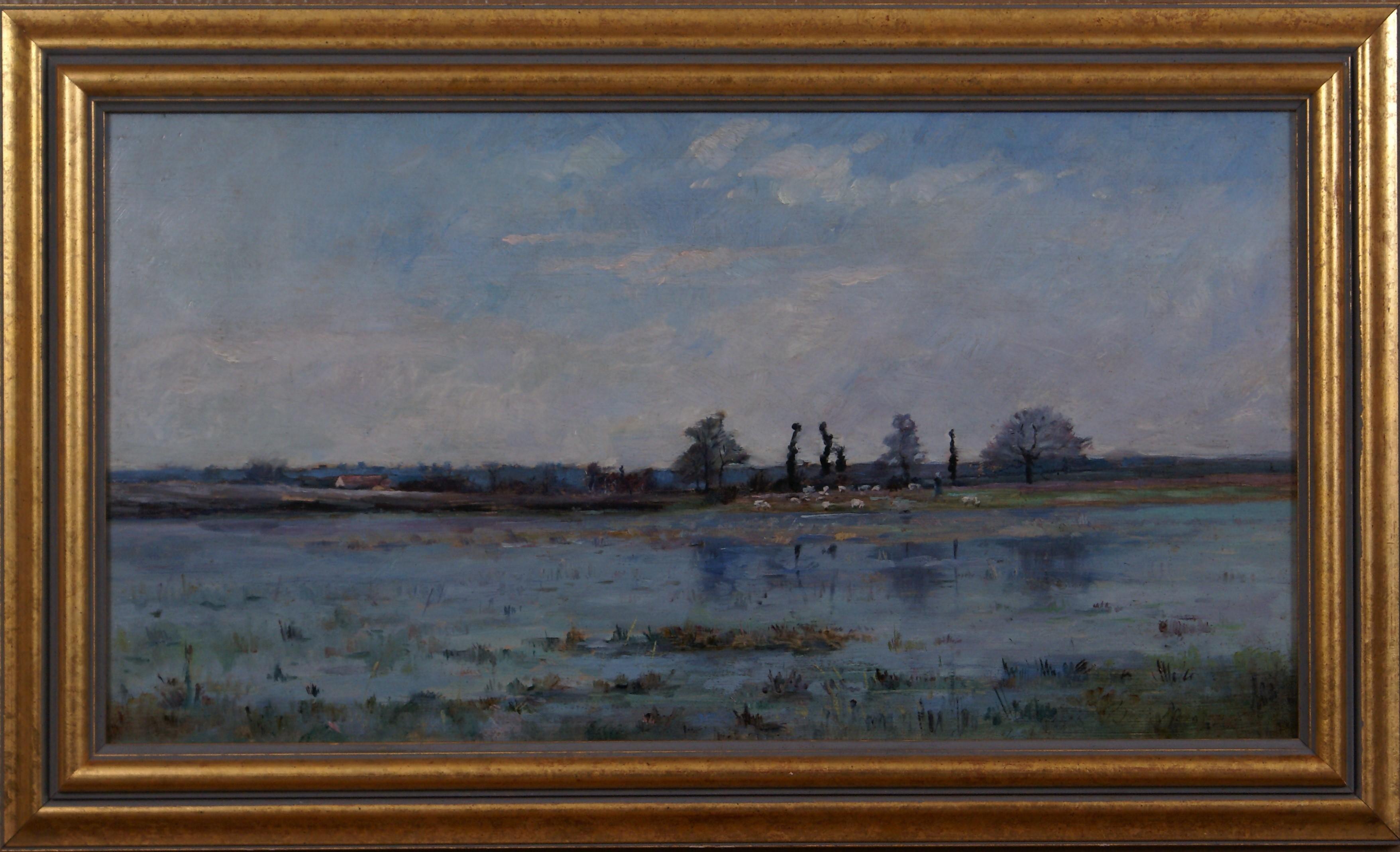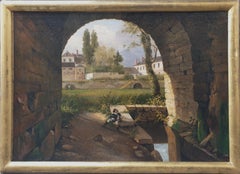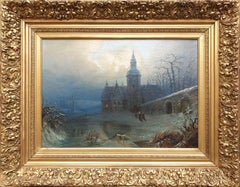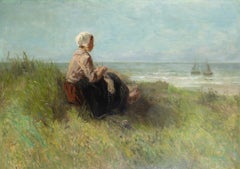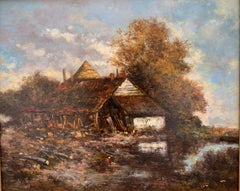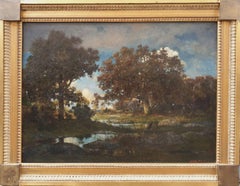
RENIE Barbizon Painting Fontainebleau landscape forest trees pond French 19th
View Similar Items
Want more images or videos?
Request additional images or videos from the seller
1 of 13
Jean Emile RENIERENIE Barbizon Painting Fontainebleau landscape forest trees pond French 19th
About the Item
- Creator:Jean Emile RENIE (1835 - 1910, French)
- Dimensions:Height: 17.33 in (44 cm)Width: 23.63 in (60 cm)
- Medium:
- Movement & Style:
- Period:
- Condition:Very good condition except for a tear of the wood panel on the right side.
- Gallery Location:PARIS, FR
- Reference Number:1stDibs: LU2524213543722
About the Seller
5.0
Vetted Seller
These experienced sellers undergo a comprehensive evaluation by our team of in-house experts.
Established in 2010
1stDibs seller since 2023
7 sales on 1stDibs
More From This SellerView All
- French neoclassical school 19th landscape near Fontainebleau Avon musketeerLocated in PARIS, FRFrench school from the mid-19th century Oil on paper 33 x 46 cm (37 x 51 cm with the frame) Inscription on the verso "Avon"Category
Mid-19th Century French School Landscape Paintings
MaterialsOil
- BREDOW Snow landscape moonlight night German Russian school romantic 19thLocated in PARIS, FRAlbert BREDOW Germany, 1828 – Moscow, 1899 Oil on canvas Signed lower right "ABredow" 43 cm x 62 cm (67 x 85 cm with frame) Albert Bredow is a German-Russian landscape painter, lit...Category
Mid-19th Century Romantic Landscape Paintings
MaterialsOil
- Painting oval KUWASSEG Marine beach boats french romantic Normandy 19thBy Charles Euphrasie KuwassegLocated in PARIS, FRCharles Euphrasie KUWASSEG Draveil (Essonne), 1833 – Paris, 1904 Oil on wooden panel Signed and dated lower right “C. Kuwasseg fils / July 57” 36 x 28 cm (42 x 36 cm with the frame)...Category
1850s Romantic Landscape Paintings
MaterialsOil
- Pierre Edouard FRERE Vue maisons Montfort L'Amaury Yvelines Impressionnist 19thBy Pierre Edouard FrereLocated in PARIS, FRPierre Edouard FRERE Paris, 1819 - Ecouen, 1886 Oil on paper on canvas Signed lower left "Ed. Fr" 24.5 x 33 cm (32 x 39 cm with the frame) Beautiful 19th century frame with canes and...Category
1870s Impressionist Landscape Paintings
MaterialsOil
- Belgian painting 19th VAN STRIJ oil on wood Lanscape cattle children ruinBy Jacob van StrijLocated in PARIS, FRJacob VAN STRIJ (Entourage of) Dordrecht, 1756 - 1815 Oil on panel 46 x 60 cm (64.5 x 79 cm with the frame) Inscription on the back “Van der Eyden? » Very beautiful 19th century frame in gilded wood Very good condition (only a few stains) Our painting is very close to the art of Jacob van Strij studied and may have been painted in the circle of this artist. Jacob van Strij studied at the Academy of Painting in Antwerp and with Andreas Lens. Back in Dordrecht, he became a landscape painter. Both individually and with his brother Abraham, he painted various wallpapers for clients in Dordrecht. According to Jacob van Strij biographer Johannes Immerzeel, “His passion and concern for faithfully imitating nature went so far that Van Strij, as ill as he was (for years Van Strij was plagued with gout) he asked someone to pull his sled along the ice in the biting cold in order to make sketches for his paintings, which he then executed in his workshop ”. Van Strij used these sketches for various paintings. He was inspired by 17th century old masters, in particular Albert Cuyp...Category
Early 19th Century Dutch School Landscape Paintings
MaterialsOil
- Landscape View Richmond Hill British 18th Circle of REYNOLDS Oil on canvasBy (Circle of) Joshua ReynoldsLocated in PARIS, FREarly 19th century English school Oil on canvas 35x55cm (50x75cm with frame) This view of the Thames from Richemond Hill is a famous site that was represented by 18th and 19th centu...Category
Early 19th Century Romantic Landscape Paintings
MaterialsOil
You May Also LikeView All
- Waiting by Jozef Israëls - Landscape oil paintingBy Jozef IsraëlsLocated in London, GBWaiting by Jozef Israëls (1824-1911) Oil on canvas 95.3 x 133.9 cm (37 ½ x 52 ¾ inches) Signed lower left, Jozef Israels A monumental painting by one of...Category
19th Century Barbizon School Figurative Paintings
MaterialsCanvas, Oil
- The Barn, Oil On Bord, Signed Jean-Charles Cazin, Barbizon School, 1865By Jean-Charles CazinLocated in Paris, FROil on panel representing a barn, signed JC Cazin on the lower left corner. Jean Charles Cazin (1840-1901) Born in Samer (his father, from Bologna,...Category
Late 19th Century Barbizon School Landscape Paintings
MaterialsOil
- Oil Painting 19th Century Cows Landscape BarbizonBy Antonio CortesLocated in Saint-Ouen, FRCORTES Antonio (1827-1908) Cows to pasture Oil on canvas signed lower left Old frame gilded with leaves Dim canvas : 54 X 65 cm Dim frame: 70 x 86 cm...Category
1860s Barbizon School Animal Paintings
MaterialsOil
- Barbizon School Lakeside Landscape With CastleLocated in Cotignac, FRAn oil on panel idyllic landscape by Boggio. The painting is signed bottom right. An idealised lakeside landscape view with a castle in the distance in the style of the Barbizon sch...Category
Mid-20th Century Barbizon School Landscape Paintings
MaterialsOil, Board
- Barbizon School Lakeside Landscape, The Shady Glen.Located in Cotignac, FRAn oil on panel idyllic landscape by Boggio. The painting is signed bottom right. An idealised lakeside landscape view of a shady glen in the style of the Barbizon school.Category
Mid-20th Century Barbizon School Landscape Paintings
MaterialsOil, Board
- The Forest, Large Barbizon School, Oil on Canvas Wooded LandscapeBy Emile Roux-FabreLocated in Cotignac, FRA French Barbizon School oil on canvas forest view by Emile Roux-Fabre. The painting is signed and dated bottom left with a dedication. A charming view of forest glade leading out to a valley landscape beyond. The artist has captured the magic feeling of the cool forest shade against the sunshine of the landscape beyond. The texture of the bark on the silver birch trees, the contrast of the leaves on the trees all framing the perspective to the view beyond. An extremely accomplished and atmospheric painting. The Barbizon school of painters was part of an art movement towards Realism in art, which arose in the context of the dominant Romantic Movement of the time. The Barbizon school was active roughly from 1830 through 1870. It takes its name from the village of Barbizon, France, on the edge of the Forest of Fontainebleau, where many of the artists gathered. Most of their works were landscape paintings, but several of them also painted landscapes with farmworkers, and genre scenes of village life. Some of the most prominent features of this school are its tonal qualities, colour, loose brushwork, and softness of form. The leaders of the Barbizon school were: Théodore Rousseau, Charles-François Daubigny, Jules Dupré, Constant Troyon, Charles Jacque, and Narcisse Virgilio Díaz. Jean-François Millet lived in Barbizon from 1849, but his interest in figures with a landscape backdrop sets him rather apart from the others. Jean-Baptiste-Camille Corot was the earliest on the scene, first painting in the forest in 1829, but his work has a poetic and literary quality which sets him somewhat apart. Other artists associated with the school, often pupils of the main group, include: Henri Harpignies, Albert Charpin, François-Louis Français and Émile van Marcke. In 1824 the Salon de Paris exhibited works of John Constable, an English painter. His rural scenes influenced some of the younger artists of the time, moving them to abandon formalism and to draw inspiration directly from nature. Natural scenes became the subjects of their paintings rather than mere backdrops to dramatic events. During the Revolutions of 1848 artists gathered at Barbizon to follow Constable's ideas, making nature the subject of their paintings. The French landscape became a major theme of the Barbizon painters. Millet extended the idea from landscape to figures — peasant figures, scenes of peasant life, and work in the fields. In The Gleaners (1857), for example, Millet portrays three peasant women working at the harvest. Gleaners are poor people who are permitted to gather the remains after the owners of the field complete the main harvest. The owners (portrayed as wealthy) and their laborers are seen in the back of the painting. Millet shifted the focus and the subject matter from the rich and prominent to those at the bottom of the social ladders. To emphasize their anonymity and marginalized position, he hid their faces. The women's bowed bodies represent their everyday hard work. In the spring of 1829, Jean-Baptiste-Camille Corot came to Barbizon to paint in the Forest of Fontainebleau, he had first painted in the forest at Chailly in 1822. He returned to Barbizon in the autumn of 1830 and in the summer of 1831, where he made drawings and oil studies, from which he made a painting intended for the Salon of 1830; "View of the Forest of Fontainebleau'" (now in the National Gallery in Washington) and, for the salon of 1831, another "View of the Forest of Fontainebleau"'. While there he met the members of the Barbizon school: Théodore Rousseau, Paul Huet, Constant Troyon, Jean-François Millet, and the young Charles-François Daubigny. During the late 1860s, the Barbizon painters attracted the attention of a younger generation of French artists studying in Paris. Several of those artists visited Fontainebleau Forest to paint the landscape, including Claude Monet, Pierre-Auguste Renoir, Alfred Sisley and Frédéric Bazille. In the 1870s those artists, among others, developed the art movement called Impressionism and practiced 'plein air' painting. In contrast, the main members of the school made drawings and sketches on the spot, but painted back in their studios. The Post-Impressionist painter Vincent Van Gogh studied and copied several of the Barbizon painters as well, including 21 copies of paintings by Millet. He copied Millet more than any other artist. He also did three paintings in Daubigny's Garden. The Barbizon painters also had a profound impact on landscape painting in the United States. This included the development of the American Barbizon school by William Morris Hunt. Several artists who were also in, or contemporary to, the Hudson River School studied Barbizon paintings for their loose brushwork and emotional impact. A notable example is George Inness, who sought to emulate the works of Rousseau. Paintings from the Barbizon school also influenced landscape painting in California. The artist Percy Gray...Category
Early 20th Century Barbizon School Landscape Paintings
MaterialsCanvas, Oil
Recently Viewed
View AllMore Ways To Browse
Francois Rousseau
Painted Jean Jacket
Fur Jean Jacket
Rossini Oil
Rossini Oil Painting
Robert Day Paintings
Mexican Tree
Vintage Graduation
American Impressionist Chicago
Beach Shore
California Ocean Painting
Marie Oil
Vintage Farm Paintings
Oil Painting From Early 20 Century
Central California Paintings
House By The Bay
Old Florida
Sailboat Painting
